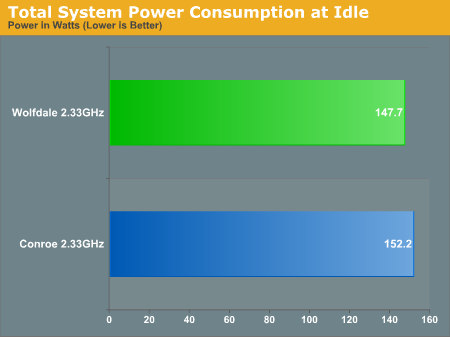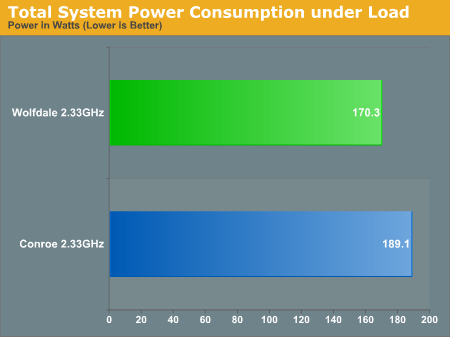The Penryn Preview - Part I: Wolfdale Performance
by Anand Lal Shimpi on August 21, 2007 12:35 PM EST- Posted in
- CPUs
Power Consumption
Obviously power consumption should go down thanks to Intel's cooler 45nm process. At idle (sitting at the desktop with no disk queue), the difference between our Conroe and Wolfdale systems is relatively small - a savings of only 3%:

Under load however (running our WME9 test) the total system power consumption gap increases to 12.6W:

Wolfdale decreases total system power consumption by around 10% compared to Conroe.










55 Comments
View All Comments
zsdersw - Tuesday, August 21, 2007 - link
The idiots who predicted a "huge improvement" existed only in your mind, I suspect.. or were never a group of any nominal size to begin with.sprockkets - Wednesday, August 22, 2007 - link
Not really. Search even this site and find stories like "30% improvement over Conroe." They painted Penryn as if it was such a major advance in technology that it would obliterate anything or anyone period had on the planet.sprockkets - Wednesday, August 22, 2007 - link
Yeah, here:http://www.dailytech.com/Intel+Unveils+Penryn+Perf...">Daily Tech Penryn "Benchmarks"
Funny How Intel benchmarked the processors and got "amazing" benefits over the previous generation. Of course they didn't do a clock for clock comparision.
coldpower27 - Thursday, August 23, 2007 - link
Most people were claiming was 5-10% improvement per clock over Conroe, and that is what the data from Anandtech and HKEPC shows, if your talking overall improvements that is trickier as it would depend on what the clockspeed as well, so up to 30%, is not impossible given the right circumstances and depending on what Yorkfield XE tops out at.Performance is not derived from just a clock per clock comparison, you also have to take into account overall clockspeed increases, cache, FSB. Don't expect any corporation to put their processors in any sort of unflattering light, it is in their best interest to make themselves look good, not bad.
zsdersw - Thursday, August 23, 2007 - link
Nowhere in the comments of that story did anyone make any wild performance claims.sprockkets - Friday, August 24, 2007 - link
No, I don't see any inflation here at all.
And if AMD can make a processor run at 3ghz on 90nm, uh, yeah, kinda expect a processor 2 generations down the process line to be able to reach 3.3ghz without issues.
zsdersw - Wednesday, August 22, 2007 - link
Again, not a group of people big enough to be significant.dualathlon - Tuesday, August 21, 2007 - link
Would you please include some wu benchmarks from FAH ?Thanks.
Rebel44 - Tuesday, August 21, 2007 - link
I would also like to see some F@H benchmarks.conquerist - Tuesday, August 21, 2007 - link
1) What HSF was used for the OC? The stock HSF or the Thermalright Ultra 120 Extreme?2) As mentioned before, how does it OC at a higher Vcore?
3) Could you use x264 for the multimedia tests? I suggest this because x264 is open source, and so you can use Intel Compiler 10 or GCC 4.3 with the msse4.1 switch to compile it in SSE4.1! It would be interesting to see how Conrow vs. Penryn SSE3 vs. Penryn SSE4 compare. You can grab a daily tarball of the source at ftp://ftp.videolan.org/pub/videolan/x264/snapshots...">ftp://ftp.videolan.org/pub/videolan/x264/snapshots....